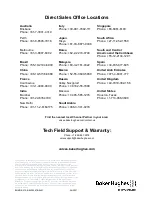
Masoneilan SVI3 Installation and Maintenance Manual
=
| 109
© 2021 Baker Hughes Company. All rights reserved.
Spring Range (Lower/Upper):
The spring range KPI as calculated by the SVI3 will normally be the Operational spring
range, as calculations will be performed while the valve is in operation. Operation spring
range includes pressure to overcome spring forces, friction added by actuator, valve
(packing, guiding surfaces, etc.), and any unbalance forces as added by the process or
application.
Spring range is calculated as both a Lower and Upper Spring Range value. Lower spring
range is defined as the pressure required to start moving the valve. Upper spring range is
defined as the pressure required to fully move the valve to its maximum travel position.
Spring range is calculated from the same data obtained for Friction and on the same time
interval (every hour). For Spring range values to calculate, data for roughly 9% of travel is
required. Changes in spring range values are important to follow, as contributing factors
could indicate spring degradation, friction changes, or process imbalances.
Stick Slip:
Stick Slip is defined as a change in setpoint with no immediate change in travel, followed
by an abrupt break free travel movement to catch up to the commanded setpoint. Stick
slip is realized within the SVI3 by closely monitoring setpoint and position, looking for
instances where setpoint moves smoothly while position moves in jumps.
Like Friction, the Stick Slip data is only collected when travel is not near the stops of the
valve and ignores very small movements. If Stick Slip is determined, the stick slip
indication will be triggered, along with an amplitude value in % of travel, to quantify the
magnitude of the stick slip.
Stick Slip is a useful leading KPI which can typically be diagnosed through the analysis of
other KPIs such as friction and helps to determine causes of cycling issues within
systems.
Position and Setpoint Cycling:
Cycling processes can be the result of the process, the positioner, or the valve. The SVI3
calculates two cycling values, Setpoint Cycling and Position Cycling, to help determine
the cause of cycling process. Setpoint cycling is defined as movement of setpoint in one
direction with a sudden change in other direction. Similarly, Position cycling is the
movement of position in one direction with a sudden change in the other direction. The
cycling KPIs use the same data filter as the stick slip algorithm.
The cycling KPIs, when used along with other KPIs, are good indicators of the source of
cycling.
• Process Cycling – If the setpoint and position cycles are similar and there is no
evidence of stick slip, or if stick slip is present and setpoint cycle amplitude is twice
the stick slip amplitude, then most likely the process is cycling.
• Valve Cycling – If stick slip is present and setpoint cycling is same or less than
stick slip, then most likely the valve is causing the cycling.

































